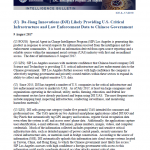The ICE Pattern Analysis and Information Collection (ICEPIC) system was established in 2008 to enable ICE law enforcement agents and analysts to look for non-obvious relationship patterns among individuals and organizations that are indicative of violations of the customs and immigration laws that are enforced by DHS agencies, as well as possible terrorist threats and plots. From these relationships, ICE agents develop specific leads and intelligence for active and new investigations. Identified relationships are also recorded for reuse in subsequent investigative analyses. The information processed by ICEPIC comes from existing ICE investigative and apprehension records systems, as well as immigration and alien admission records systems. ICEPIC includes capabilities that assist investigators in recording results of analyses performed in support of investigations and in capturing additional relevant information obtained from outside sources. The information collected by, on behalf of, in support of, or in cooperation with DHS and its components may contain personally identifiable information collected by other Federal, State, local, tribal, foreign government agencies, or international organizations.
Read more →


